湖南省衡南县向阳镇初级中学七年级英语下册 Unit 6 Topic 1 There is a study next to my bedroom知识点总
最新(仁爱版)七年级下册Unit6topic1知识全解(2021年整理)

最新(仁爱版)七年级下册Unit6topic1知识全解(word版可编辑修改) 编辑整理:尊敬的读者朋友们:这里是精品文档编辑中心,本文档内容是由我和我的同事精心编辑整理后发布的,发布之前我们对文中内容进行仔细校对,但是难免会有疏漏的地方,但是任然希望(最新(仁爱版)七年级下册Unit6topic1知识全解(word版可编辑修改))的内容能够给您的工作和学习带来便利。
同时也真诚的希望收到您的建议和反馈,这将是我们进步的源泉,前进的动力。
本文可编辑可修改,如果觉得对您有帮助请收藏以便随时查阅,最后祝您生活愉快业绩进步,以下为最新(仁爱版)七年级下册Unit6topic1知识全解(word版可编辑修改)的全部内容。
Unit 6 Our Local AreaTopic 1 there is a study next to my bedroom。
I 重点词汇1.住房相关词汇:bedroom , floor, upstairs, house, kitchen, garden, door, window,yard, bathroom,2.常见家具词汇:table, chair, lamp, key, clock3.乐器名词:guitar4.方位介词:near under front behind center left5.序数词:first second6.其他动词:put7.其他名词:thing flower modelII 重点短语Section AWelcome to my new home.欢迎来到我的新家 Have a beautiful garden。
有一个漂亮的花园 On the second floor 在二楼 next to靠近,邻近 and so on等等 why not为什么不 go upstairs 上楼 have a look看一看 dining room餐厅 living room客厅Section BTalk about 谈论 in your study在你的书房 study on the computer在电脑上学习 on the desk 在桌子上 on the wall 在墙上 near the desk在桌子旁边 so many books太多书 so much water 大量水 on the shelves 在书架上 under the chair 在椅子下面 in front of 在…前面(范围以外) in the front of 在…前面(范围以内) behind the door 在门后面 play with 同…玩耍 look after 照顾 put away把…收好Section Cin the center of 在…中心 at the back of在…后面 in the tree 在树上 on the left of 在…左边 on the right of 在…右边 help sb。
新湘教版初中英语七年级下Unit 6 Topic 1 Section A PPT
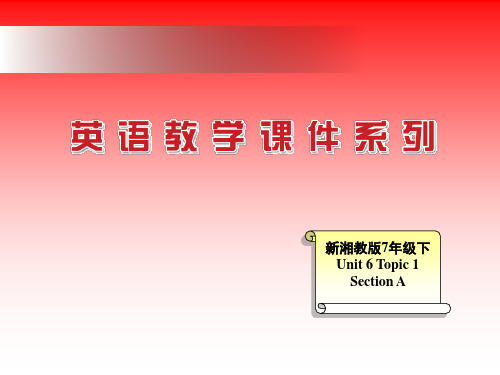
Pair work
A: ___ Where is living room? B: It’s on the first floor. A: Where is your bedroom? B: It’s on the second floor. Is there A: ____ a study on the second floor? Yes, there is B: ____. It’s next to my bedroom. Are there A: ____ any bedrooms on the first floor? No, there aren’t. B:___ . But there are two on the second floor.
谢谢各位老师莅临指导!!
Look ,listen and say
Listen to the tape and find the answers to the following question: Is there a computer in Jane’s study? Yes, there is.
Key points
Is there…. Are there …. Nest to … Why not …. Can I borrow…
Consolidation
1 Follow it sentence by sentence , paying attention to the pronunciation and intonation 2 Practice and act out the dialog in front of the class.
Pair work
Draw a picture of your own house. Then tell your partner about your favorite room. 1 Which is your favorite room? 2 What’s in the room? 3 What do you use that room for?
仁爱版七年级英语下册Unit6topic1教材讲解.doc

Unit 6 Our Local AreaTopic 1 Is there a computer in your study?一.重难点讲解1、There is / are…(1)用法:There be "有",其确切含意为"某处或某时存在某人或某物。
"其结构是:There be + 某人或某物+ 表示地点或时间的状语。
There be 后面的名词实际上是主语,be 动词的形式要和主语在数上保持一致,be动词后面的名词是单数或不可数名词时用is,名词是复数时用are。
(2)几种基本句式:There is a book and two pens on the desk. 桌上有一本书和两支笔。
There are two pens and a book on the desk. 桌上有两支笔和一本书。
There isn’t a book on the desk. 桌上没有一本书。
There aren’t two pens on the desk. 桌上没有两支笔。
Is there a book on the desk? Yes, there is. No, there isn’t. 桌上有一本书吗?是的,有。
不,没有。
Are there two pens on the desk? Yes, there are. No, there aren’t. 桌上有两支笔吗?是的,有。
不,没有。
(3)与have的区别:2、It’s on the second floor.There is a study next to my bedroom.它在二楼。
我卧室的隔壁有一间书房。
(1)floor “地板;楼层”,常以介词on连用。
表示楼层时,英美之间是有区别的:英国美国一楼:the ground floor the first floor二楼:the first floor the second floor三楼:the second floor the third floor在表示几层楼的房间时,不用floor,而用story(美)或storey(英) Eg: a five-story/storey house 一栋五层的房间。
七年级英语下册Unit6 Topic1知识点汇总
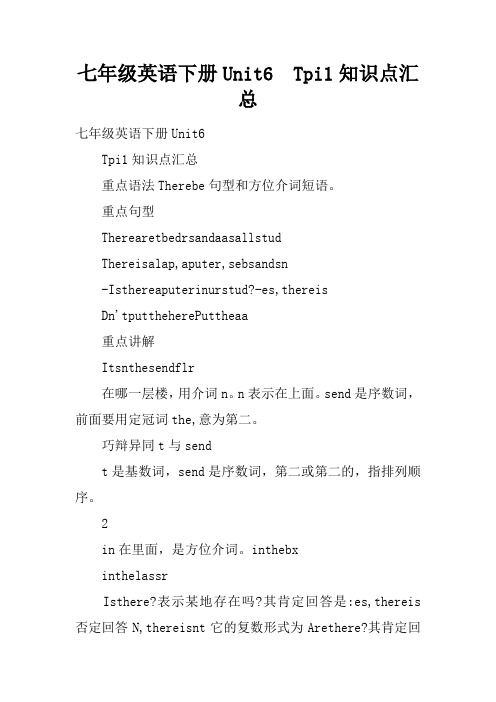
七年级英语下册Unit6 Tpi1知识点汇总七年级英语下册Unit6Tpi1知识点汇总重点语法Therebe句型和方位介词短语。
重点句型TherearetbedrsandaasallstudThereisalap,aputer,sebsandsn-Isthereaputerinurstud?-es,thereisDn'tputtheherePuttheaa重点讲解Itsnthesendflr在哪一层楼,用介词n。
n表示在上面。
send是序数词,前面要用定冠词the,意为第二。
巧辩异同t与sendt是基数词,send是序数词,第二或第二的,指排列顺序。
2in在里面,是方位介词。
inthebxinthelassrIsthere?表示某地存在吗?其肯定回答是:es,thereis 否定回答N,thereisnt它的复数形式为Arethere?其肯定回答是:es,thereare否定回答N,therearent3巧辩异同therebe与havetherebe有,指存在有。
have有,指人或某物拥有。
TheisadginthepitureThedghastbigees注:therebe遵循就近原则。
be用is还是are,取决于离该动词最近的那个名词。
如果该名词是单数或不可数名词就用is,如果是复数就用are。
4haveal看看。
后面接名词时要用at如havealaturathtalabut谈论,议论,后接名词或动名词。
talith/t与某人交谈6用来询问某地有某物,其结构为:hats+介词短语,回答时应用therebe句型。
7plaith和玩耍,玩plaithsb与某人一起玩8putaa把放好9lafter保管,照顾,相当于taeareflat看llie看起来像lfr寻找lthesae看起来一样巧辩异同inthetree与nthetreeinthetree指外来物体在树上。
nthetree树木本身长出来的花、树叶等。
英语初一下仁爱湘教版unit6topic1sectiona教案
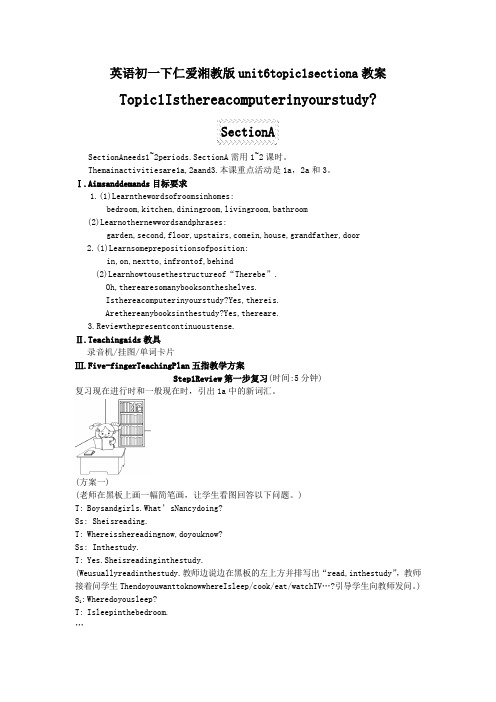
英语初一下仁爱湘教版unit6topic1sectiona教案Topic1Isthereacomputerinyourstudy?SectionASectionAneeds1~2periods.SectionA需用1~2课时。
Themainactivitiesare1a,2aand3.本课重点活动是1a,2a和3。
Ⅰ.Aimsanddemands目标要求1.(1)Learnthewordsofroomsinhomes:bedroom,kitchen,diningroom,livingroom,bathroom(2)Learnothernewwordsandphrases:garden,second,floor,upstairs,comein,house,grandfather,door2.(1)Learnsomeprepositionsofposition:in,on,nextto,infrontof,behind(2)Learnhowtousethestructureof“Therebe”.Oh,therearesomanybooksontheshelves.Isthereacomputerinyourstudy?Yes,thereis.Arethereanybooksinthestudy?Yes,thereare.3.Reviewthepresentcontinuoustense.Ⅱ.Teachingaids教具录音机/挂图/单词卡片Ⅲ.Five-fingerTeachingPlan五指教学方案Step1Review第一步复习(时间:5分钟)复习现在进行时和一般现在时,引出1a中的新词汇。
(方案一)(老师在黑板上画一幅简笔画,让学生看图回答以下问题。
)T: Boysandgirls.What’sNancydoing?Ss: Sheisreading.T: Whereisshereadingnow,doyouknow?Ss: Inthestudy.T: Yes.Sheisreadinginthestudy.(Weusuallyreadinthestudy.教师边说边在黑板的左上方并排写出“read,inthestudy”,教师接着问学生ThendoyouwanttoknowwhereIsleep/cook/eat/watchTV…?引导学生向教师发问。
仁爱版七年级英语下册Unit 6 Topic 1 There is a study next to

Unit 6 Topic 1 There is a study next to my bedroom Section D导学案【学习目标】:1. 知识目标:A:总结there be句型及方位介词(短语),同时复习用how many 和how much对可数名词的数和不可数名词的量进行提问;B:复习“谈论方位、建议、请求、命令、房间布局、家庭摆设以及其他房间设施”等交际功能意义的表达,进行笔头操练并加以总结。
2.过程与方法与他人合作,共同完成学习任务;能逐步养成预习和复习的好习惯;.在英语学习中积极思考;运用图片、关键词、实物等完成课堂活动。
3.情感态度价值观:能够听取、接受他人的建议;能够与同伴积极合作,参与课堂活动,大胆实践。
★【学习重点】:.在Sections A-C已学的基础上,能自行总结there be句型及方位介词(短语),同时复习用how many 和how much对可数名词的数和不可数名词的量进行提问;★【学习难点】:结合话题,运用“谈论方位、建议、请求、命令、房间、布局以及其他房间设施”等交际功能意义的表达,进行笔头操练并加以总结。
★【学习内容】:【自主学习】:(同学们自己先学一学吧,老师知道你们很棒!)1. 单词过关(默写下列单词):默写下列家居词汇或词组:花园____________ 卧室____________ 厨房____________餐厅____________ 地板____________ 浴室____________楼上____________ 客厅____________2.词组过关:默写下列动词短语:欢迎来到_________________ 看看_________________ 上楼_________________谈论进来玩弄收好照顾写信给3.翻译下列方位介词或短语:在…上面____________ 在…下面___________在…里面____________在…后面____________ 在…附近____________与…相邻______ 在…后部___________在…和…间__________ __ 在…中心______ ________ ___在…左边______ ___ ________ 在…右边____________ _____3.句型过关。
仁爱版七年级英语下册Unit 6 Topic 1 There is a study next to

Unit 6 Topic 1 There is a study next to my bedroom Section B导学案【学习目标】:1. 知识目标:A:正确朗读并运用本节课生词:lamp, clock, near, under, chair, behind, front, in front of, guitar, window, table, key, put, away, put away, door, look after, thingB:能够正确使用there be句型的复数、特殊疑问句、一般疑问句及其肯定和否定回答;C:能正确使用方位介词或介词短语,如:on, in, in front of, behind, near, under等;D:能够就“存在、请求、命令”等交际功能的基本法进行交流和对话操练,如:(1)—Is there a student in front of the classroom?—No, there isn’t.(2)Put it/them away, please.(3)You must look after your things.E:掌握字母组合i+nd/ld, igh, -ing, l/ll, m/mn的发音规则并尝试辨音;2、过程与方法能与他人合作,共同完成学习任务;能够在英语学习中积极思考;能够运用图片、关键词、实物等进行听前预测。
3、情感态度价值观:能在学习的同时,热爱自己的生活环境;能够与同伴积极合作,参与课堂活动,大胆实践。
★【学习重点】:能够在情景对话中,熟练运用there be句型的复数、特殊疑问句、一般疑问句及其肯定和否定回答来谈论房间的物品摆设和方位。
★【学习难点】:能够在情景对话中,熟练运用there be句型的复数、特殊疑问句、一般疑问句及其肯定和否定回答来谈论房间的物品摆设和方位。
★【学习内容】:【自主学习】:(同学们自己先学一学吧,老师知道你们很棒!)1. 单词过关(默写下列单词):灯___ _______ 钟___ _______ 在…附近___ _______ 在…下面___ _______前面___ _______ 后面___ _______ 椅子___ _______ 吉他___ _______窗户___ _______ 桌子___ _______ 钥匙___ _______ 放___ _______离开___ _______ 东西___ _______2.词组过关:谈论在电脑上在墙上进来如此多(cn.)如此多(un.)在前面在前部玩弄收好照顾相邻3. 句型过关1).你的书房里有英语书吗?2).教室前面有什么?3).有老师在教室的前面吗?4).在你的书桌上有什么?5).沙发在书桌附近。
英语七年级下仁爱湘教版 unit6 topic1 sectiona课件概要

9
当堂训练:(堂清) a、必做题:背诵默写2b、3(组员当面给组长
写 组长当面给课代表默写,课代表交由老师检测)
b、在厨房_____
3、have dinner _____ 4、play games _____ 5 、 在花园 _____ 6、在门后面 ______
后教: 时间:5分钟左右 内容:针对本节所学内容中仍有疑问 的地方或发现新问题,如没有问题开始 背诵2b和3中的短语。
方法:同桌小组间再次讨论,或举手 问老师。
8
本节课你学到了什么?
本节课学习了学校建筑物的名 本节课巩固复习了 there be 句型的 称以及现在进行时态。
陈述句,一般疑问句及其答语。学 会了用in, on, behind等方位介词来 描述物品的位置。
A: Are there any books in the study? B: Yes, there are.
5
3 Pair work
A: Where is your father? B: He’s in front of the house. A: What’s he doing? B: He’s cleaning the car. mother in front of the house sisters brother in the kitchen in the study sleep cook play games read books
1、Read and translate 2b和3. 2、通过造句试着区分 in front of和in the front of a、我家前有一棵树。 b、 教室前面有一张黑板。
时间:8分钟左右 方法:结合课后注释遇到问题,同桌 小组可讨论或举手问老师。 检测方式:以口答或小组抽查的方式检测 4 要求:紧张,高效,每位学生都要有自学结果
英语初一下仁爱湘教版英语:unit6topic1练习

英语初一下仁爱湘教版英语:unit6topic1练习I.用所给词的适当形式填空1.What__________(be)inthetree?Therearetwobirds.2.Arethere___________(some)booksonthedesk?3.What’sonthe___________(teacher)desk?4.There__________(be)muchmoneyinthebank.5.Mybedroomisonthe__________(two)floor.6.Thedogisa____________(use)animal.7.Thankyoufor___________(tell)methenews.8.Whynot_________(listen)tomusic?9.Thereisasofainthe_________(live)room.10.They___________(play)computergamesatthemoment.II.单项选择()1.----______ismyblouse?----It’sonthebed.A.WhatB.whoC.Where()2.---CanIborrowyourEnglishbook,please?----Sure.Please______soon. A.givebackB.givebackitC.giveitback()3.---Whereisthelivingroom?---It’s_____thesecondfloor.A.onB.underC.before()4.Letmehavealook______yournewcomputer.A.forB.afterC.at()5.______doeshegobackhome?A.WhatB.WhenC.Who()6.There______somebooksandapenonthedesk.A.areB.isC.have()7.There______abagandsomeballsbehindthedoor.A.areB.isC.have()8.There_____somewaterinthebottle.A.hasB.areC.is()9.---What______onthedesk?---Therearesomebooksonit.A.isB.areC.am()10.---Whichisyourfavoriteroom?---_______.A.ThestudyB.TheflowersC.Thedining-table()11.There______30boysand20girlsinourclass.A.areB.beC.isD.have()12._____thereanywaterinyourglass?A.HasB.AreC.IsD.Be()13.Thekitchenis______thesecondfloor.A.onB.inC.nexttoD.of()14.Whynot_____computergames?A.playingB.toplayC.playsD.play()15.---___?---Theredoneunderthetree.A.WhichisMr.King’scarB.WhatisMr.King’scarC.WhereisMr.King’scarD.WhichcarisMr.King’s()16.---Whoistheboyoverthere?---_____.A.HeisatschoolB.he’sfromJapanC.It’smyfriend,JimD.Sorry,Idon’tknow()17.---What’sthenumberofthebus?---_____.A.I’melevenB.NineC.It’sthreeo’clockD.Class9()18.---What’sontheteacher’sdesk?____somebooks,apenandaruler.A.ThereB.There’sC.ThereareD.Therehas()19.---Whatcolourisyoursweater?---It’s_____.A.anorangeB.orangesC.orangeD.aorange()20.---IsthatMrs.Brown’sblouse?---Yes,It’s______.A.She’sB.her’sC.herD.hers()21.---What’sonthewall?---There___amapofChinaonit.A.areB.isC.haveD.has()22.---Howmany___arethereinyourbasket,Jeff?---Onlythree.A.riceB.orangeC.eggsD.fruit()23.Howmany___arethereintheinternationalvillage?A.ChineseB.RussianC.American()24.---It’stimeforsports.---Let’s___oursportsshoes!A.putawayB.putupC.putonD.putdown()25.---___comeandjoinusinthegame?---___.ButImustmeetmyuncleattheairport.A.Whynotto;IthinksoB.Whynot;IhopesoC.Whydon’tyou;I’mverytiredD.Whynotyou;Ilikeit()26.Youmust___thisSunday.A.givebackB.givebackitC.giveitbackD.returnitback()27.---What___onthedesk?---Anappleandsomeoranges.A.areB.isC.beD.have()28.---Aretheyyourbooks?---Please___.A.putawayitB.putitawayC.putthemawayD.putawaythem()29.Look!Theboyisplaying___hisdog.A./B.forC.withD.of()30.Whynot___outforawalk?A.togoB.goesC.goingD.go()31.Marialoves___booksinherstudy.A.readingB.readC.lookingD.seeing()32.Let’swatchTB___awhile.A.forB.atC.withD.on()33.Icanseesomeapples___thetreeandabird___thetree.A.in,inB.on,inC.at,inD.in,on()34.---Tomisathome.---___.Heisatschool.A.Yes,heisB.IthinksoC.No,heisD.Idon’tthinkso()35.Excuseme,Mike.Iwantto___yourEnglishbookforaweek,OK?A.takeB.bringC.putD.keepIII.句型转换1.HeiswatchingTVathomenow.(用often代替now)He____________TVathome.2.Mymothergoestoworkbybike.(划线提问)______________yourmothergotowork?3.LucysitsinRowFive.(改为现在进行时态)Lucy_______________inRowFivenow.4.Hedoesn’thaveanynewbooks.(改为确信句)He_____________newbooks.5.Thereisabookonthedesk.(改为一般疑问句,并作确信,否定回答)_________________abookonthedesk?Yes,______________.No,_____________.6.Thereisatreeinthegarden.(划线提问)________inthegarden?7.There’resomebooksandapeninthebag.(改为一般疑问句)_______there______booksandapeninthebag?8.Jackisnearthegate.(划线提问)______isnearthegate?9.Mytrousersareunderthebed.(划线提问)______________yourtrousers?10.Thatisherphoto.(划线提问)______photoisthat?11.Thereisaguitaronthewall.〔对划线部分提问〕_______________________onthewall?12.Therearesomestampsinthestampalbum!〔改为一般疑问句〕______________________________stampsinthestampalbum?13.Isthereabiggardenbehindthehouse?〔作否定回答〕__________,___________________.14.Therearethreeroomsoneachfloor.〔对划线部分提问〕________________________________arethereoneachfloor?15.Myshoesareunderthebed.〔对划线部分提问〕____________________myshoes?16.IsthereaTVintheroom?〔作否定回答〕_________,___________________.17.Isthereafootballunderthechair?〔作确信回答〕___________,_____________________.18.Thepictureisinherstudy.〔对划线部分提问〕_______________________thepicture.19.Therearesomechairsanddesksintheclassroom.〔改为否定句〕_____________________________chairs_______desksintheclassroom.20.Therearealotofbooksonthetable.〔对划线部分提问〕____________________onthetable?IV.依照中文意思完成句子1.你的卧室在哪里?在二楼。
仁爱版英语七年级下册Unit6topic1sectionA说课稿
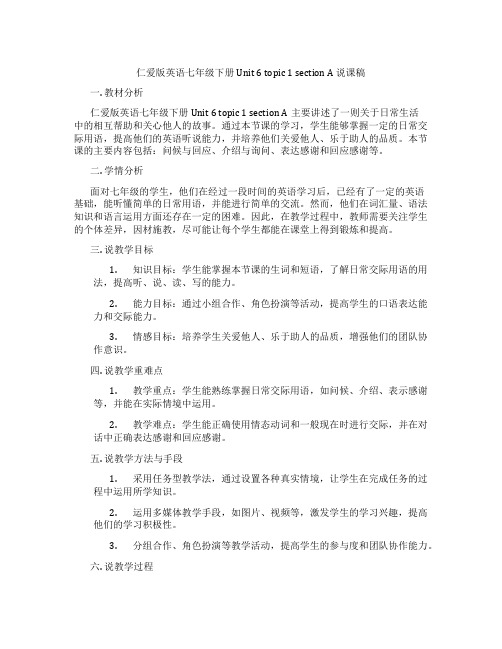
仁爱版英语七年级下册Unit 6 topic 1 section A 说课稿一. 教材分析仁爱版英语七年级下册Unit 6 topic 1 section A主要讲述了一则关于日常生活中的相互帮助和关心他人的故事。
通过本节课的学习,学生能够掌握一定的日常交际用语,提高他们的英语听说能力,并培养他们关爱他人、乐于助人的品质。
本节课的主要内容包括:问候与回应、介绍与询问、表达感谢和回应感谢等。
二. 学情分析面对七年级的学生,他们在经过一段时间的英语学习后,已经有了一定的英语基础,能听懂简单的日常用语,并能进行简单的交流。
然而,他们在词汇量、语法知识和语言运用方面还存在一定的困难。
因此,在教学过程中,教师需要关注学生的个体差异,因材施教,尽可能让每个学生都能在课堂上得到锻炼和提高。
三. 说教学目标1.知识目标:学生能掌握本节课的生词和短语,了解日常交际用语的用法,提高听、说、读、写的能力。
2.能力目标:通过小组合作、角色扮演等活动,提高学生的口语表达能力和交际能力。
3.情感目标:培养学生关爱他人、乐于助人的品质,增强他们的团队协作意识。
四. 说教学重难点1.教学重点:学生能熟练掌握日常交际用语,如问候、介绍、表示感谢等,并能在实际情境中运用。
2.教学难点:学生能正确使用情态动词和一般现在时进行交际,并在对话中正确表达感谢和回应感谢。
五. 说教学方法与手段1.采用任务型教学法,通过设置各种真实情境,让学生在完成任务的过程中运用所学知识。
2.运用多媒体教学手段,如图片、视频等,激发学生的学习兴趣,提高他们的学习积极性。
3.分组合作、角色扮演等教学活动,提高学生的参与度和团队协作能力。
六. 说教学过程1.热身(5分钟):通过播放一首关于相互帮助的歌曲,引导学生进入学习状态,同时营造轻松愉快的课堂氛围。
2.引入(10分钟):教师展示一幅图片,引导学生进行观察和思考,引出本节课的主题。
3.呈现(10分钟):教师通过展示PPT,教授本节课的生词和短语,让学生跟读并模仿。
湖南省衡南县向阳镇初级中学七年级英语下册 Unit 5 Topic 1 I usually come to school by subway知识点总结
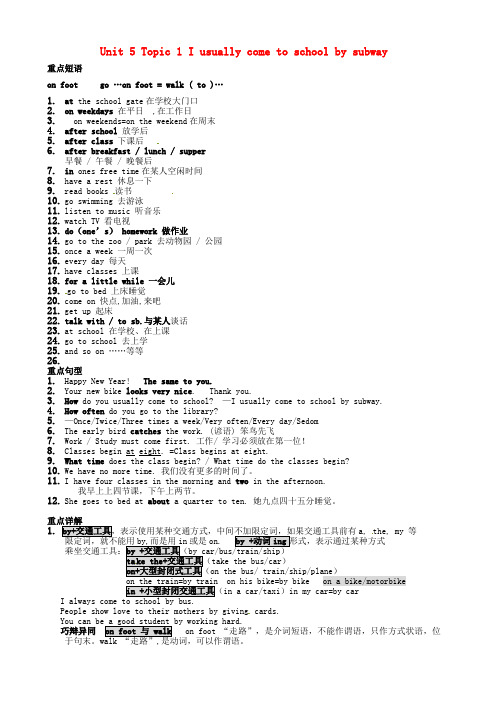
Unit 5 Topic 1 I usually come to school by subway重点短语on foot go …on foot = walk ( to )…1.at the school gate在学校大门口2.on weekdays在平日,在工作日3.on weekends=on the weekend在周末4.after school 放学后5.after class 下课后6.after breakfast / lunch / supper早餐 / 午餐 / 晚餐后7.in ones free time在某人空闲时间8.have a rest 休息一下9.read books 读书10.go swimming 去游泳11.listen to music 听音乐12.watch TV 看电视13.do(one’s) homework 做作业14.go to the zoo / park 去动物园 / 公园15.once a week 一周一次16.every day 每天17.have classes 上课18.for a little while 一会儿19.go to bed 上床睡觉e on 快点,加油,来吧21.get up 起床22.talk with / to sb.与某人谈话23.at school 在学校、在上课24.go to school 去上学25.and so on ……等等26.重点句型1.Happy New Year! The same to you.2.Your new bike looks very nice. Thank you.3.How do you usually come to school? —I usually come to school by subway.4.How often do you go to the library?5.—Once/Twice/Three times a week/Very often/Every day/Sedom6.The early bird catches the work. (谚语) 笨鸟先飞7.Work / Study must come first. 工作/ 学习必须放在第一位!8.Classes begin at eight. =Class begins at eight.9.What time does the class begin? / What time do the classes begin?10.We have no more time. 我们没有更多的时间了。
英语初一下仁爱湘教版unit6topic1sectiona学案

英语初一下仁爱湘教版unit6topic1sectiona 学案SectionA 〔1a —2b 〕第组检查预习等级学科组长教学过程【一】课前自主学习:〔Comeon,Ican!〕1.自主预习P.25--26相关内容的单词,并勾画出难懂的短语和句子。
2.从教材P25-26中找出下面的短语,进行英汉互译。
欢迎到我的新家_________________onthesecondfloor______________nextto__________havealook___________在你的书房___________________ 什么原因不来楼上amomentlater请进来____________在书架上_____________在一楼3.自主学习教材P117,小组合作完成以下内容:therebe 句型的构成形式为:,表示。
Thereisabookonthedesk.(翻译)Therearesomestudentsontheplayground.(翻译)在河上有只船。
(翻译)在体育馆有一些学生。
(翻译)注意:therebe 句型中,遵循的原那么,be 动词的形式由决定。
组长检查签字【二】课堂合作与探究。
1.充分运用多媒体和教室资源复习现进时态,引入therebe 句型,学习并灵活运用therebe 句型的陈述句,一般疑问句及其答语。
2.教学1a —2b.----【三】展示与提升。
小组合作用therebe 句型造句:〔比一比,看哪组造的又对又多〕【四】当堂训练:〔20分〕〔PK 台,看看谁最棒?〕A.依照汉语提示完成句子〔每题一分,共5分〕1.Wesleepinthe(卧室)。
2.Mariasits(挨着)Tom.4.Mystudyisonthe(第二)floor.5.(有)manygirlsinthrgym.B.单项选择〔每题一分,共5分〕1.WhynothomeandwatchTV?A.goB.togoC.going2.Isthereaclocknexttothephoto?.A.Yes,itis.B.Yes,thereis.C.Yes,thereisn ’t.3.Theresomementeachersintheoffice.A.haveB.isC.are4.Thereiaakitchenonthefloor. 学习目标: 1.学习教材P25的11个生词和短语。
- 1、下载文档前请自行甄别文档内容的完整性,平台不提供额外的编辑、内容补充、找答案等附加服务。
- 2、"仅部分预览"的文档,不可在线预览部分如存在完整性等问题,可反馈申请退款(可完整预览的文档不适用该条件!)。
- 3、如文档侵犯您的权益,请联系客服反馈,我们会尽快为您处理(人工客服工作时间:9:00-18:30)。
Unit 6 Topic 1 There is a study next to my bedroom重点词组Why not… =Why don’t you…1.go upstairs上楼 go downstairs下楼2. A moment later一会以后3.study n.书房 v.学习与learn的区别4.in the front of the house在屋子(里面的)前面5.in front of the house在屋子(外面的)前面6.talk about+n/v-ing谈论,议论,讨论某事7.talk with sb. 与某人交谈8.put them away把他们收拾好9.Look after = take care of照顾10.play with sb. “与某人一起玩”11.in the tree(外物附着)在树上12.on the tree树本身长出来的花,树叶等13.on the wall在墙上14.in the wall在墙里15.on the river浮在水面上16.over the river 在河上(悬空)17.Tell sb about sth Tell sb to do sth Tell sb sth18.want sb to do sth/want to do sth19.There be…用法重点语法There be 句型表示“某处存在某物或某人,表示一种客观存在,而have“有”,表示“某人拥有某物/某人”表主观拥有,其主语是人。
There is a dog in the picture. The dog has two big eyes.当have表示“包括”、“存在”的含义时,There be 句型与其可互换。
eg. A week has seven days. =There are seven days in a week.肯定句:There is a computer in your study.否定句--在“be”后加“not”: There isn’t a compute r in your study.一般疑问句--将“be”提到“there”之前: Is there a computer in your study?----Yes, there is./ No, there isn’t.特殊疑问句:There be句型的特殊疑问句形式有以下三种变化:①对主语提问:当主语是人时,用"Who's+介词短语?";当主语是物时,用"What's + 介词短语?"。
注:无论原句的主语是单数还是复数,对之提问时一般都用is(回答时却要根据实际情况来决定)。
如:There are many things over there. →What's over there?There is a little girl in the room. →Who is in the room?②对地点状语提问:提问地点用"Where is / are+主语?"“There + be+主语+地点状语”表示“某处有某物”;例:There is a computer on the desk. → Where is the computer?There are four children on the playground. →Where are the four children?地点状语也可放在句首,有时可用“,”与后面的部分隔开。
There are some pictures on the wall.=On the wall, there are some pictures.③对数量提问:一般有两种句型结构:How many+复数名词+are there+介词短语?How much+不可数名词+is there+介词短语?there be...则.。
.There be如果后面接两个名词作主语,那么“be”的人称和数..就近原.......遵循与邻近的名词一致。
即be.......................,取决于离该动词最近的那个名词。
如果该名..are..用.is..还是词是单数或不可数名词就用...。
.........are............is..,如果是复数就用★就近原则: There is a lamp , a computer, some books and so on.There are two boys and a girl under the tree.重点句型 There are two be drooms and a a small study.There is a lamp, a computer, some books and so on.—Is there a computer in your study? —Yes, there is.Don't put them here. Put them away.There are many beautiful flowers in the garden,but there aren’t any trees in it. 花园里有许多漂亮的花,但是却没有树。
重点讲解1.It’s on the second floor. 在哪一层楼,用介词on。
on表示在……上面。
second是序数词,前面要用定冠词the, 意为第二(的)。
on the first floor美式英语一楼floor地板,此处指“楼房的层”。
英式英语用the ground floor 表示一楼巧辩异同two与secondtwo是基数词,second是序数词,“第二”或“第二的”,指排列顺序。
2. have a look看看。
后面接名词时要用at. 如have a look at your watch.3. put away 把……放好Don’t put them here. Put them away.别把它们放在这儿,请收起来放好。
4. look after“保管,照顾”,相当于take care of.‘’l ook at看…… look like看起来像…… look for寻找look the same看起来一样You must look after your things.你必须保管好你的东西。
5. like to do sth 和 like doing sth的区别二者都表示"喜欢做某事",A. like doing sth表示长时间的喜欢做某事,指兴趣爱好。
在意义上比较一般和抽象,时间观念不强,不指某一次动作;例:She likes swimming.她喜欢游泳。
(经常性的,爱好)I like eating fish .(我喜欢吃鱼,个人口味而已,一种爱好,喜欢)I love playing on the computer in the study. 我喜欢在书房玩电脑。
(love doing sth.=like doing sth. 喜欢做某事)B. like to do sth则常指某个具体的动作,表示偶尔一次喜欢做某事、或者突然喜欢干某事。
与love to do相似C. like to do sth 想去做某事(表示有个趋向性,好像是要到某处去做某事)如: She likes to swim this afternoon.她今天下午想游泳。
(特指某一次的动作)另外,在搭配(使用方法)上,“ like to do ”一般与“ would ” 搭配表示意愿。
例:I would like to swim with you . 我愿意和你去游泳。
Would you like to skate ? 你愿意去滑冰吗?6. get a letter from sb. 收到某人的来信=hear from sb.hear from宾语是人不是信,hear of听说某人(物),hear听到,听见,侧重听的结果。
常用hear sb doing sth/do sthI’m very glad to get a letter from you.我很高兴收到你的来信。
6.Welcome to my new home.【home作n.】 (对比Welcome home【home作adv.】)8. so/too many+可数名词复数=many eg: There are so many books in the desk.so/too much+不可数名词 =much There is so much water in the ri ver.much too+adj ==too太... I’m much too tired.9. 方位短语:in the center of=in the middle of在...中间in front of 在...前面(外部)in the front of(内部)在...前面at the back of 在...后面on the left/right of在...的左边/右边next to 紧邻10. go up”沿着“指往北走,或从小地方往大地方走go down往南走,从大地方向小地方去go along “沿着...往前一直走”11. a ticket for+n/ving eg: a ticket for parking.12. used to do:"过去常常"表示过去习惯性的动作或状态,但现在不再。
be used to do被用来做某事; The knife is used to cut apples.be used to doing习惯于做某事,to是介词,后需加名词或动名词。
Tom is used to going for a walk after dinner.(现在习惯于散步)13.肯定的祈使句:(1) 实义动词原形+其他;(2) be动词原形+形容词+其他;(3) Let sb do sth.否定的祈使句:(1) Don’t+实义动词+原形;(2) Don’t be+形容词+其他;(3) Don’t let sb do sth (4) No+Ving.练:(1) M y mother said to me, “Tom, _______ in bed.”A. not readB. doesn’t readC. don’t readD. didn’t read(2) Don’t __________ (fight). = No __________ (fight).14. 不要迟到:Don’t arrive late. = Don’t be late. (arrive = be)上课/上学不要迟到:Don’t arrive (be) late for class/school.15. 主语省略(无主语):Do n’t arrive late for class.主语不省略(有主语):We can’t arrive ;ate for class.。
